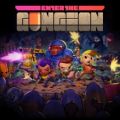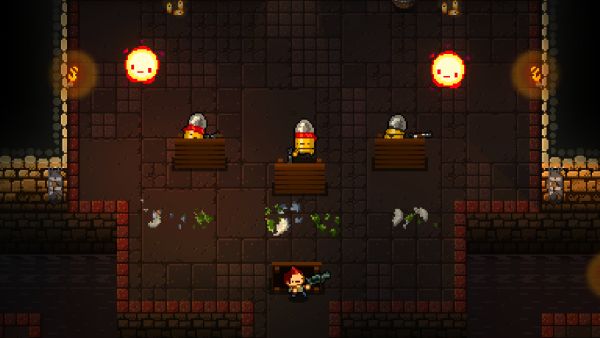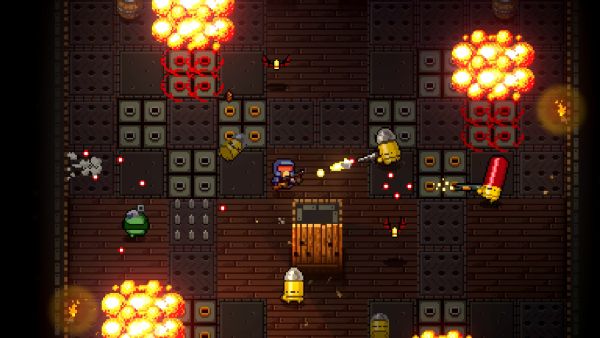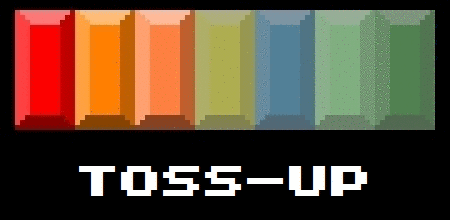
Strange though it may seem, in 2016, video games are an old medium. The various genres and mechanics of the medium have, over time, formed a kind of complex language that makes sense to those who are video game literate but is impenetrable to those who aren’t. Good guys are blue, bad guys are red. This is simple if you’ve played a few shooters, but is not immediately obvious. This creates a problem for the critic when describing a game’s mechanics: to some people, Red Dead Redemption is a simulation of the Old West in which you meet with people who need tasks doing; to others, it’s GTA with horses.
Enter the Gungeon is a top-down, twin-stick shooter in which you explore procedurally generated dungeon floors armed with weapons, bombs, keys, and a special item. You fight your way through each floor looking for shops and item rooms to arm yourself for the boss fight that allows you to move down to the next floor of the dungeon. It’s usually best to avoid comparisons, but if this description reminds you of The Binding of Isaac, then you’re on the right track.
Platforms: PC, PS4 (Version Played)
Publisher: Devolver Digital
Developer: Dodge Roll Games
Genre: Top-Down Roguelike-like Bullet-Hell Shooter
Release Date: April 5, 2016
ESRB Rating: Everyone 10+
 Enter the Gungeon is a fairly derivative game that follows the success of other recent recent roguelikes, by using the difficulty, permadeath, and procedurally-generated dungeons of Rogue. Anyone familiar with the exemplars of the roguelike – or roguelike-like – genre will spot borrowed mechanics and ideas at every turn. As mentioned, Gungeon borrows its overall structure from Isaac, but there’s also the shopkeeper and tunnel man from Spelunky, and the invincibility roll and weapon-focused combat of Nuclear Throne. What Enter the Gungeon lacks in originality it makes up for in execution, for all of these features are neatly tied together by combat that stays interesting after many hours with the game.
Enter the Gungeon is a fairly derivative game that follows the success of other recent recent roguelikes, by using the difficulty, permadeath, and procedurally-generated dungeons of Rogue. Anyone familiar with the exemplars of the roguelike – or roguelike-like – genre will spot borrowed mechanics and ideas at every turn. As mentioned, Gungeon borrows its overall structure from Isaac, but there’s also the shopkeeper and tunnel man from Spelunky, and the invincibility roll and weapon-focused combat of Nuclear Throne. What Enter the Gungeon lacks in originality it makes up for in execution, for all of these features are neatly tied together by combat that stays interesting after many hours with the game.
Although Enter the Gungeon is a top-down, twin-stick shooter, it differentiates itself from its predecessors by allowing you to flip tables to create cover, thereby giving the combat a tactical element, and by having most of the boss fights immediately devolve into bullet-hell chaos that makes every victory feel miraculous.
The history of video game development (and indeed, the history of all creative media) is the history of a series of trends. While these trends are sometimes imagined as being teleological, with some defined endpoint in mind, even momentary study of video game history will reveal not a progression, but rather a succession of vogues. Graphics are an excellent example of this: “photorealism” was once bandied about as the endpoint and artistic zenith of video game graphics, but the current popularity of retro-style graphics, like those in Enter the Gungeon, shows this to be untrue.

RPG-style progression systems have been implemented in almost all types of video games for some time now, and this design choice has remained popular for such a long time that I would hesitate to call it a passing fad like most other design choices. Indeed, the ubiquity of progression systems is such that, no longer satisfied with finding them only in games, we now use them as a kind of metagame for our lives, with apps and games like Epic Win and Habitica awarding players XP for doing 20 press-ups or washing the dishes.
RPG mechanics are popular because they allow us to feel as though we are always progressing, that all of our time playing the game was worth it, so to speak. Of course, very often this feeling is used as a quick-fix in development, making those parts of the game that fail to be enjoyable seem as if they are at least useful.
Enter the Gungeon introduces many different mechanics over the course of the game in a way that makes sense, and is perhaps even necessary. During your time with the game, Gungeon’s hub area fills with characters who all provide you with different things to do on your next attempt at the gungeon. This solves one of the problems that I have with The Binding of Isaac and Nuclear Throne, as you unlock not just new weapons and items, but also new ways to interact with the game and explore the gungeon, making each playthrough feel useful. The functions of many of these characters are obscure at first, and the game makes little effort to explain the interesting ways that they can impact your game. Having all of the characters from the start would have been so daunting as to push me away from the game, so unlocking them through a progression system is an important and, what’s more, fun way to lend weight to each attempt at the gungeon.

Enter the Gungeon’s implementation of a hub peopled by vendors and quest givers is a genuine development of the genre that makes it easy to recommend Gungeon to anyone who enjoyed Isaac and Nuclear Throne, and which will also make those games harder to return to. Enter the Gungeon learns from the mistakes of its forebears, and though this essentially just means a meaty progression system and warp devices that make traversing the floors easier (this, by the way, is hugely important), it is impossible to deny the impact of these mechanics. Unfortunately, Gungeon disappoints, and even surprises, in that it fails to learn from the successes of Isaac and others.
The Binding of Isaac was first released in 2011, Spelunky in 2012, and Nuclear Throne appeared on Early Access is 2013. The greatest testament to the quality of these games is that I still play them even now, and they are not yet showing signs of age. That might seem like a high standard to hold a game to, but these three owe their legs to the great amount of variety in the game. Nuclear Throne has a huge cast of characters that all play very differently. Spelunky’s areas are all radically different, constantly confronting you with new enemies and surprises that keep you on your toes. Each game of Isaac will lead you to uncover fascinating new items that disfigure your character in great, disgusting ways. While its source is different in each case, it is the sheer variety of these games that keeps them fresh, and it is this variety that Enter the Gungeon fails to use.
Considered on its own, Enter the Gungeon is a great game. The shooting is hard as hell, without ever feeling unfair, and has a heavy, punchy feel. The design is also great fun: everything is built around the iconography of guns and bullets with an entertaining and impressive consistency. Of course, when a game borrows so liberally from other games, it seems wrongheaded to consider it in a vacuum, and so comparisons with other games are inevitable. Some of this comparison casts favourable light on Gungeon, but when I think of Isaac and its huge array of enemy types and strange equipment that makes every playthrough feel unique, I can’t help but feel that Gungeon would benefit from at least having some characters with distinctive play styles. Enter the Gungeon offers a huge list of weapons, and while this focus on firearms is consistent with the game’s fiction, the fact remains that, except for a few notable exceptions such as the beehive gun, a gun always is and will remain, just a gun.
But by all means, check out Enter the Gungeon… you’ll have a great time! Just don’t expect it to keep pulling you back in for years the same way its big brothers can.

Review Disclosure: A retail copy of Enter the Gungeon was purchased by Warp Zoned for the purposes of this review.






